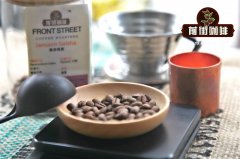How to make Jamaica Blue Mountain Coffee how to make Blue Mountain Coffee Bean siphon and hand Water temperature Grinding time parameters

Professional coffee knowledge exchange more coffee bean information please follow the coffee workshop (Wechat official account cafe_style)
Qianjie-Jamaica Blue Mountain Coffee brewing parameters sharing
V60 filter cup:
Hario V60 series filter cup mouth is relatively large, coupled with unique spiral curve ribs, making the air flow easier to be derived, improving the extraction quality; rib design can extract soluble substances in a short time, mainly in the way of flushing, taste light like fruit juice, bringing out obvious sweet and sour and aroma. With different ways and methods of water injection, you will also get coffee with different taste and flavor, which is more playable.
Prepare 15g powder, water temperature 88 degrees, grinding degree BG 6S (Chinese standard 20 sieve, 60% pass rate), water powder ratio close to 1:15
Technique: first steam with 30g water, the steaming time is 30s, pour water against the flour, the first water injection to 120g cut off water, when the water level drops 1 inch 3-1 / 2, then the second water injection, water injection to 225g stop, cooking time is controlled at about 2 minutes 05 seconds.
Flavor: the taste of Blue Mountain Coffee is very clean, very mild, sweet chocolate, very mellow. The taste is full-bodied and mellow. the sweet, sour and bitter taste of the coffee is perfect, with no bitterness at all, only a moderate and perfect sour taste and a long fruity taste. Kono, kalita fan-shaped, cake cup cooking, the concentration is increased, the taste is solid, thick and strong, while the V60 filter cup boils, refreshing and sweet taste, sugar sweetness, the end will have nuts, high concentration of dark chocolate aftertaste and back sweet.
Knowledge gift: the water temperature of hand-brewed coffee is generally 92-95 °, according to the roasting degree of coffee beans. Because the roasting degree of Blue Mountain coffee belongs to medium-deep roasting, the choice of water temperature is shallower than that of medium-shallow roasting, because if the water temperature of medium-deep roasting exceeds 90 °, it is easy to extract bitter taste.
END
Important Notice :
前街咖啡 FrontStreet Coffee has moved to new addredd:
FrontStreet Coffee Address: 315,Donghua East Road,GuangZhou
Tel:020 38364473
- Prev

An introduction to the volcanic flushing and cooking techniques of the Japanese hand brewing genre spread in the coffee industry? The coffee made by the volcano is
Professional coffee knowledge exchange more information on coffee beans please follow the Coffee Workshop (Wechat official account cafe_style) Coffee industry spread the seven hand flushing genres of the volcano. 1. Why is it called volcanic flushing? It works like a volcanic eruption. 2. Generally use deep-baked soybean powder (deep-baked soybean powder will give off more gas, which is beneficial to bulging). 3. When flushing, it should be in the center of Xiao Fan.
- Next

Hawaiian Kona Coffee introduces how expensive kona Coffee is
Professional coffee knowledge exchange more coffee bean information please follow the coffee workshop (Wechat official account cafe_style) Front Street-Hawaii Kona Coffee knowledge introduction Hawaiian Coffee has a rich history. In 1825, the first coffee beans were planted here. Oahu was imported from Brazil at that time. The area proved to be attractive. With the coffee
Related
- Beginners will see the "Coffee pull flower" guide!
- What is the difference between ice blog purified milk and ordinary milk coffee?
- Why is the Philippines the largest producer of crops in Liberia?
- For coffee extraction, should the fine powder be retained?
- How does extracted espresso fill pressed powder? How much strength does it take to press the powder?
- How to make jasmine cold extract coffee? Is the jasmine + latte good?
- Will this little toy really make the coffee taste better? How does Lily Drip affect coffee extraction?
- Will the action of slapping the filter cup also affect coffee extraction?
- What's the difference between powder-to-water ratio and powder-to-liquid ratio?
- What is the Ethiopian local species? What does it have to do with Heirloom native species?

